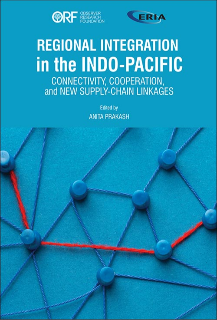Introduction
Opportunities and disruptions arising in the Indo-Pacific region can be addressed through economic cooperation strategies that can recognise and include different stages of industrial development in countries in Asia, the Pacific, Africa, Europe, as well as the United States (US). The Indo-Pacific economic architecture responds to the different policy and plan needs of developing and developed parts of Asia and the Pacific. Along with the need for achieving high and sustained growth in developing countries and least developed countries in the region, there is greater recognition for ensuring equitable, spatially even, and inclusive economic growth amongst all stakeholders.
It is often said that change is a recognition of and adaptation to new needs. The Asia-Pacific represented the post-war construct of the economic rise and institutional maturing in several countries in East and Southeast Asia. The phenomenal economic gains of the Asian Tigers, the political and economic success of the Association of Southeast Asian Nations (ASEAN) community, and the growing importance of the Pacific Island countries all contributed to the successful construct of economic cooperation in the Asia-Pacific region. During this phase, the US and, to a lesser degree, the European Union (EU), were important guarantors of the strategic and economic interests of most countries in the region.
Along this growth trajectory, the rise of China aided the economic dynamism of the region for nearly two decades. China’s economy helped Asia remain a bright spot of growth even during the global financial crisis of 2008. Asia and the Pacific provided tailwinds to the global economy during this time. The 2008–2015 period was also when most developed economies took time-out to offset the adverse effects of the financial crisis on their financial, political, and social institutions.
Around the same time, developed and developing Asia, despite relative comfort in terms of growth and prosperity as well as trade openness, became vulnerable to a unilateral interpretation of the status quo in the South and East China Sea. The strategic activities in the two seas caused ripple effects on the economic linkages in Southeast and East Asia. The deep global value chain (GVC) connectivities amongst Southeast Asian countries and China, and between Japan and China, as well as the exchange of investments amongst them all created a ground for dissatisfaction with the existing economic architecture, notwithstanding the ensured economic returns from existing trade integration with China and the complexity involved in unravelling the backward–forward integration of exports in several important sectors.
The introduction of the Belt and Road Initiative in 2015 (and its critical evaluation) could be viewed as the policy convergence point for governments in Asia and Europe as well as in the US to mobilise support for the Indo-Pacific economic architecture in which strategic and economic interests are brought closer than what most trade economists would favour. In other words, the emergence of the Indo-Pacific economic architecture is similar to the conditions when Japanese and US investment initiatives in Southeast Asia during the post-war period galvanised the Asia-Pacific. Policy and political leadership are the primary movers of the new architecture, which will eventually be supervised by economic returns.
To say that the evolution of the Indo-Pacific economic architecture is aimed at the containment of China is a simplistic explanation. The Indo-Pacific undoubtedly addresses China centrality in production sharing in the region and the dependency of the EU and the US on the supply chains of China. From a policy research perspective, the Indo-Pacific economic architecture is more than a reaction to the existing production networks and investment channels in the region. The evolution of this architecture is a preparation for new economic demands before all countries in the region. Structural transformation and employment generation policies in developing Asia and the Pacific must understand, prepare, and respond to the new digital economy, as the latter will affect the patterns and geographical location of industries, employment, trade, and economic growth. Increased industrialisation and participation in GVCs are important for growth and employment generation in several less developed countries. The future of work is vulnerable to decreased investments in manufacturing, and jobs being replaced by automation, robotics, and artificial intelligence, especially for countries that are not deeply integrated in regional or global value chains.
Geographical inclusiveness is an important aspect of the Indo-Pacific architecture. The role of smaller countries—especially the Pacific Island states, which are new entrants to the regional connectivity plans—is particularly recognised in this study and for the future monitoring of economic performance in the Indo-Pacific. Human resources and the movement of people are equally linked with the new digital economy as well as the future of work. Interweaving these elements of cooperation into economic cooperation in the Indo-Pacific will prepare the region for the future.
The COVID-19 pandemic reinforced the need for more equitable distribution of infrastructure and capacities and investments in new centres of production, supply chains, and consumer/supplier clients. While there are several interpretations of the effects of the pandemic on supply chains, two extreme examples underscore the need for a more enabled, equitable, and inclusive economic cooperation model for the region. The breakdown of the supply of medical equipment and kits from China during the pandemic and the regional distribution of vaccines produced in India in the latter part of the pandemic are emblematic of the problems and solutions before the Indo-Pacific economic architecture.
Trade and investment have underwritten the growth story in the Indo-Pacific. The digital economy is, however, here to stay. As industries, employment, trade, and economic growth continue to change under the influence of digitalisation, the Indo-Pacific region must reap the benefits of this progress. The Indo-Pacific architecture must ensure that digitalisation promotes inclusiveness, especially for youth and women. Asia, Europe, and the US have different levels of digital infrastructure. However, cooperation for the development of services, human capital, regulations for data protection, e-commerce, and taxation require greater institutional linkages amongst all stakeholders. The emergent supply chains and cooperation frameworks will bridge these needs in the Indo-Pacific.
The Indo-Pacific economic architecture is linked to restoring multilateralism that recognises diversity yet leaves no one behind. It is worth noting that multilateralism has provided stability and prosperity to a great number of countries for nearly a century. Global governance of connectivity is also a new challenge, as countries contest and compete for technology that provides interconnections. Managing the internet is most apparent, but the technology underlying electronic commerce and the financial system is much more significant. The traditional chapters of trade agreements—on goods, services, and investment—while still contentious, are now subordinate to the field of technology. The Indo-Pacific economic architecture has no choice but to undertake global actions which aim to resolve this challenge.
In the end, neither multilateralism nor global governance exists for its own sake. The ultimate test for both is to create prosperity that is inclusive and sustainable. The Indo-Pacific economic architecture must consolidate its initiatives, spell out the principles of cooperation, and provide action on its preferred aspects of plurilateral/multilateral economic cooperation and global governance.
This study is an attempt to consolidate information on the Indo-Pacific economic architecture along six important verticals: infrastructure, GVC integration, development cooperation, digital economy, human resources and the movement of people, and geographical inclusiveness for the Pacific. The rebalancing of old elements of trade integration and the introduction of new elements of cooperation in which strategic and economic interests are brought closer to principles of governance, transparency, equity, and inclusiveness emerge as the core of the emergent architecture in the Indo-Pacific.
The Indo-Pacific is a plurilateral component of the international economy in which regions and countries find it mutually advantageous to work cooperatively. However, it brings the Atlantic and Pacific powers much closer to the Indian Ocean to emphasise cooperation and international production sharing that involve services as much as goods. The transformations brought about by this cooperation architecture must fulfil the objectives of mutual trust and mutual growth. The challenge is not to maintain a rules-based system but to create and operate institutions that evolve and sustain rules in the face of change, and the relationships must all be inclusive. To that extent, ‘Connectivity, Cooperation, and New Supply Chain Linkages’ will be central to the agenda of the Indo-Pacific economic architecture.
Read the entire report here.
The views expressed above belong to the author(s). ORF research and analyses now available on Telegram! Click here to access our curated content — blogs, longforms and interviews.

 PDF Download
PDF Download



 PREV
PREV


